Hi all.
I have just ordered a SMSL Q5 Pro which seems to be getting decent reviews. Although i was wondering if anybody has made any successful mods to increase the performance of the amp?
I have just ordered a SMSL Q5 Pro which seems to be getting decent reviews. Although i was wondering if anybody has made any successful mods to increase the performance of the amp?
My amp just got in! First impressions are really good. They are pairing quite ok with my open-baffle beasts, but EQ settings are causing a bit problems. I assume that EQ0 preset is disabling the EQ (hopefully).
Hi
had my q5 pro about a month now - fascinating device - took a while to get used to the sound signature. I find up to a few watts its probably the most uncoloured sound I have experienced.. exposes poor recordings and poor mp3s so might not be everyone's taste.
Beginning to feel its a pretty true sound as I have some masters recorded by myself and its the most like the way i remember the sessions since loosing the studio.
I find past a few watts things get a tiny bit strange and hard occasionally .. I find this when the signal is high (optical) and the gain is above 20. Even more odd is if you can take it slightly harder then it goes v loud before getting v harsh (good for a party!).
I think I have read somewhere that the pulse (class D) amp part uses open loop gain .. which would make the device very susceptible to poor power supply (poor ripple rejection) and I am not sure the one supplied is up to the job.
To counter this I have tried adding extra power supply capacitors (low esr) close to the amp but I don't think I would be able to tell the difference 'blind'.
My next plan is to get 3 x 6v lead acid batteries in series to see if a pretty rock solid supply allows a few more watts with the sweetest sound etc..
I am sure you have sussed by now that EQ0 is in fact no EQ
i will keep you posted as to progress.
had my q5 pro about a month now - fascinating device - took a while to get used to the sound signature. I find up to a few watts its probably the most uncoloured sound I have experienced.. exposes poor recordings and poor mp3s so might not be everyone's taste.
Beginning to feel its a pretty true sound as I have some masters recorded by myself and its the most like the way i remember the sessions since loosing the studio.
I find past a few watts things get a tiny bit strange and hard occasionally .. I find this when the signal is high (optical) and the gain is above 20. Even more odd is if you can take it slightly harder then it goes v loud before getting v harsh (good for a party!).
I think I have read somewhere that the pulse (class D) amp part uses open loop gain .. which would make the device very susceptible to poor power supply (poor ripple rejection) and I am not sure the one supplied is up to the job.
To counter this I have tried adding extra power supply capacitors (low esr) close to the amp but I don't think I would be able to tell the difference 'blind'.
My next plan is to get 3 x 6v lead acid batteries in series to see if a pretty rock solid supply allows a few more watts with the sweetest sound etc..
I am sure you have sussed by now that EQ0 is in fact no EQ
i will keep you posted as to progress.
Hi,
unfortunately the power stage in this amp, the TAS5342, is not a closed loop one. This not only effects the power supply rejection, but the overall distortion as well.
TI has some close loop power stages too, like the TAS561xA/LA series, but they are not pin compatible.
Other week point of this amp can be the output inductors as I see the googled photos. These are simple power inductors which may change inductance
with the output current quite early. Higher the volume, more distortion they make. TI has a nice app.note on these issues in SLAA701A.pdf. They did
measurements on various class-D rated inductors and the variation is big, see fig28/29 !
All that means swapping the output inductors for better types, like the mentioned Wurth or Coilcraft can also improve the fidelity, but can be challenging
due to the size of these parts.
BTW other similar amp, the I.AM.D V200 looks better on these issues, they have close loop power stage and more decent output filter inductors.
unfortunately the power stage in this amp, the TAS5342, is not a closed loop one. This not only effects the power supply rejection, but the overall distortion as well.
TI has some close loop power stages too, like the TAS561xA/LA series, but they are not pin compatible.
Other week point of this amp can be the output inductors as I see the googled photos. These are simple power inductors which may change inductance
with the output current quite early. Higher the volume, more distortion they make. TI has a nice app.note on these issues in SLAA701A.pdf. They did
measurements on various class-D rated inductors and the variation is big, see fig28/29 !
All that means swapping the output inductors for better types, like the mentioned Wurth or Coilcraft can also improve the fidelity, but can be challenging
due to the size of these parts.
BTW other similar amp, the I.AM.D V200 looks better on these issues, they have close loop power stage and more decent output filter inductors.
Hi .. interesting stuff .. thanks for that.
Having been inside to add a capacitor I feel there will be room to sub some inductors and now I will have a crack at that too I think.
I am interested to see what a more 'fixed' power supply will do too .. I am not sure I can detect changes in average distortion figures when they are below 0.01% or even 0.1% for that matter..amongst all that a speaker gives us, but I do wonder about the reproduction of transients and inter-modulation effects which is not so easy to measure. I cant help feeling the use of heavy feedback to compensate for poor linearity in the amp and poor power supply, is bound to have an adverse effect on very fast changing signals (just a theory .. I have absolutely nothing to back it up but my ears!!) . But I am wondering if its this that may give this amp it first few watts of magic. Its the only dac/amp I have ever owned where my animals sometime awaken and look at the relevant speaker where a new sound has just emanated .. looking convinced something is there...
will keep you posted.
Having been inside to add a capacitor I feel there will be room to sub some inductors and now I will have a crack at that too I think.
I am interested to see what a more 'fixed' power supply will do too .. I am not sure I can detect changes in average distortion figures when they are below 0.01% or even 0.1% for that matter..amongst all that a speaker gives us, but I do wonder about the reproduction of transients and inter-modulation effects which is not so easy to measure. I cant help feeling the use of heavy feedback to compensate for poor linearity in the amp and poor power supply, is bound to have an adverse effect on very fast changing signals (just a theory .. I have absolutely nothing to back it up but my ears!!) . But I am wondering if its this that may give this amp it first few watts of magic. Its the only dac/amp I have ever owned where my animals sometime awaken and look at the relevant speaker where a new sound has just emanated .. looking convinced something is there...
will keep you posted.
Hi,
I cannot comment on TAS5342 + beefier PS, but I tried cap banks and battery on
TAS5631 and TAS5614xA power stages and they don't have any impact on the already excellent sound quality.
The reason is they are closed loop parts. TI doesn't say too much about what makes them closed loop, but I guess
those power stages compensate PWM signal coming from TAS5508 according to the actual PS noise and FET switching distortion.
It is a kind of feedback of course, but not as much as in a std class AB or analog PWM amp with global feedback.
All together I'm happy with that amount of feedback and std notebook PS🙂
Regarding pets, according to wiki https://en.wikipedia.org/wiki/Hearing_range,
dogs and cats hear much beyond human, up to 40..70 Khz. These amps put out quite a lot of noise starting from 25Khz
and up to 300Khz. Maybe your pets hear/notice this noise too if your tweeter is good enough 🙂
I cannot comment on TAS5342 + beefier PS, but I tried cap banks and battery on
TAS5631 and TAS5614xA power stages and they don't have any impact on the already excellent sound quality.
The reason is they are closed loop parts. TI doesn't say too much about what makes them closed loop, but I guess
those power stages compensate PWM signal coming from TAS5508 according to the actual PS noise and FET switching distortion.
It is a kind of feedback of course, but not as much as in a std class AB or analog PWM amp with global feedback.
All together I'm happy with that amount of feedback and std notebook PS🙂
Regarding pets, according to wiki https://en.wikipedia.org/wiki/Hearing_range,
dogs and cats hear much beyond human, up to 40..70 Khz. These amps put out quite a lot of noise starting from 25Khz
and up to 300Khz. Maybe your pets hear/notice this noise too if your tweeter is good enough 🙂
I just picked one up as well. Did some quick cursory listening last night.
First off, it was a weird feeling to take something audio-related out of a box, plug it in, and have it work! I've been pure DIY for many years now, normally getting something to work at least requires a little soldering.
Previous electronics were a dual tpa3118 mono amps (my own design), and balanced dual-mono Soekris dam1021 DACs. Source was a Raspberry Pi connected to the dam1021's via I2S.
First thing I noticed from the SMSL Q5 Pro was the bass! I've heard people make comments about the tpa311x chips being weak in the bass. Never noticed it until now. Already I have a feeling if I went back to the tpa311x, I'd miss the bass.
The rest of the sound did not offend. My gut feel was the mids and highs maybe aren't as smooth as they were with the previous electronics. But, I spent maybe a total of 40 minutes listening, and that was very casual listening. At least half the time was just playing with the remote and buttons. I certainly didn't make any attempt at real critical listening.
Not sure I how I feel about the idea of "burn in", but I left it running all night and even today while at work. Probably won't have time for any extended listening sessions until the weekend.
The included laptop-style PSU is 19V; likewise, the DC input label on the device itself says 19V. Does anyone know if I can safely run this thing at other voltages? In particular, I'd like to feed it 13.8V from an Astron power supply. That's the only "mod" I can really do right now, as all my stuff is boxed up for a move to a new house. (Which was the justification for buying this thing in the first place: one small device that just works so I can pack up all the DIY clutter I have strewn about the house.)
First off, it was a weird feeling to take something audio-related out of a box, plug it in, and have it work! I've been pure DIY for many years now, normally getting something to work at least requires a little soldering.
Previous electronics were a dual tpa3118 mono amps (my own design), and balanced dual-mono Soekris dam1021 DACs. Source was a Raspberry Pi connected to the dam1021's via I2S.
First thing I noticed from the SMSL Q5 Pro was the bass! I've heard people make comments about the tpa311x chips being weak in the bass. Never noticed it until now. Already I have a feeling if I went back to the tpa311x, I'd miss the bass.
The rest of the sound did not offend. My gut feel was the mids and highs maybe aren't as smooth as they were with the previous electronics. But, I spent maybe a total of 40 minutes listening, and that was very casual listening. At least half the time was just playing with the remote and buttons. I certainly didn't make any attempt at real critical listening.
Not sure I how I feel about the idea of "burn in", but I left it running all night and even today while at work. Probably won't have time for any extended listening sessions until the weekend.
The included laptop-style PSU is 19V; likewise, the DC input label on the device itself says 19V. Does anyone know if I can safely run this thing at other voltages? In particular, I'd like to feed it 13.8V from an Astron power supply. That's the only "mod" I can really do right now, as all my stuff is boxed up for a move to a new house. (Which was the justification for buying this thing in the first place: one small device that just works so I can pack up all the DIY clutter I have strewn about the house.)
Interesting, in the UK these are now just over £110 so approaching 'worth taking a punt' territory 😀. Perhaps in the next week or two I'll order one if I can figure out a good digital source to use (I need an Android or Ipad with digital output).
This to me sounds like the inductor cores are too small or the wrong material;- unless one of the pre-amp stages is causing it.
Mine will be getting air-cores like SMSL put into the SA-60 if I get one but I suspect any suitable core would bring huge benefits.
I think any voltage from 12V to 20 would probably be fine.
past a few watts things get a tiny bit strange and hard occasionally .. I find this when the signal is high (optical) and the gain is above 20. Even more odd is if you can take it slightly harder then it goes v loud before getting v harsh (good for a party!).
This to me sounds like the inductor cores are too small or the wrong material;- unless one of the pre-amp stages is causing it.
Mine will be getting air-cores like SMSL put into the SA-60 if I get one but I suspect any suitable core would bring huge benefits.
I think any voltage from 12V to 20 would probably be fine.
Hi,
12V powering : TAS5342 needs 12V for the FET driver stage. If they make it
with a simple 78L12, what would be a logical low cost choice, the kit may not run from 13.8V. Other than that it should work fine. You can try it, won't kill it.
Air core : I wouldn't use air core inductor in this amp. One way it will make a lots of magnetic field into the air, what may disturb other sensitive circuits like oscillators and PLLs in the TAS55x8 and USB/SPDIF chips.
On the other hand air core won't likely give you any benefit over a reasonable iron powder core inductor. This amp is limited by the open loop design, your first enemy is power supply rejection and FET switching distortion.
You can easily make similar inductors like the Coilcraft. Use std T94-2 iron powder core, 30..35 turns will give you the 7.5 - 10 uH inductance. Use 0.8 mm diameter wire or thicker. T94-2
In low power applications you can actually put the two inductors of a channel onto a single core. 2x 21 turns gives you the equivalent of 2x 7.5 uH. But be careful with the polarity of the turns, wrong polarity gives you 0 uH effective inductance!!!
Other than the above you may also check the type of the output filter film capacitors. Here you want to use polypropylene type, like WIMA MKP4
Other types has serious AC voltage derating by frequency. WIMA
12V powering : TAS5342 needs 12V for the FET driver stage. If they make it
with a simple 78L12, what would be a logical low cost choice, the kit may not run from 13.8V. Other than that it should work fine. You can try it, won't kill it.
Air core : I wouldn't use air core inductor in this amp. One way it will make a lots of magnetic field into the air, what may disturb other sensitive circuits like oscillators and PLLs in the TAS55x8 and USB/SPDIF chips.
On the other hand air core won't likely give you any benefit over a reasonable iron powder core inductor. This amp is limited by the open loop design, your first enemy is power supply rejection and FET switching distortion.
You can easily make similar inductors like the Coilcraft. Use std T94-2 iron powder core, 30..35 turns will give you the 7.5 - 10 uH inductance. Use 0.8 mm diameter wire or thicker. T94-2
In low power applications you can actually put the two inductors of a channel onto a single core. 2x 21 turns gives you the equivalent of 2x 7.5 uH. But be careful with the polarity of the turns, wrong polarity gives you 0 uH effective inductance!!!
Other than the above you may also check the type of the output filter film capacitors. Here you want to use polypropylene type, like WIMA MKP4
Other types has serious AC voltage derating by frequency. WIMA
I finally pulled the PCB out of this and looked it over, took some pics.
Looks like they used 78M12, which as far as I can tell, is effectively the same as 78L12, but supports higher current. At least for the ones made by ON Semi, minimum input voltage is 14V, so 13.8 is cutting it too close I think. (But I believe I can adjust the Astron above 13.8, so I might be able to use it yet.) On the other end, it says max is 35V, so I I might be able to experiment with something above 19V... but not too much above that, the big PSU decoupling cap is 25V.
Practical considerations might rule out air core anyway, as you can see from the pics this thing is tiny, and there's not much room for bigger inductors. Definitely no way to get air crores in there if you want to use the stock case. The tiny size of this thing has scared me away from doing any mods other than simple PSU switching.
At any rate, here are some pics. The one of me holding it up is just to give a sense of scale. The remote control is two finger widths' wide, and barely longer than my fingers.
12V powering : TAS5342 needs 12V for the FET driver stage. If they make it
with a simple 78L12, what would be a logical low cost choice, the kit may not run from 13.8V. Other than that it should work fine. You can try it, won't kill it.
Looks like they used 78M12, which as far as I can tell, is effectively the same as 78L12, but supports higher current. At least for the ones made by ON Semi, minimum input voltage is 14V, so 13.8 is cutting it too close I think. (But I believe I can adjust the Astron above 13.8, so I might be able to use it yet.) On the other end, it says max is 35V, so I I might be able to experiment with something above 19V... but not too much above that, the big PSU decoupling cap is 25V.
Air core : I wouldn't use air core inductor in this amp. One way it will make a lots of magnetic field into the air, what may disturb other sensitive circuits like oscillators and PLLs in the TAS55x8 and USB/SPDIF chips.
On the other hand air core won't likely give you any benefit over a reasonable iron powder core inductor. This amp is limited by the open loop design, your first enemy is power supply rejection and FET switching distortion.
Practical considerations might rule out air core anyway, as you can see from the pics this thing is tiny, and there's not much room for bigger inductors. Definitely no way to get air crores in there if you want to use the stock case. The tiny size of this thing has scared me away from doing any mods other than simple PSU switching.
At any rate, here are some pics. The one of me holding it up is just to give a sense of scale. The remote control is two finger widths' wide, and barely longer than my fingers.
Attachments
-
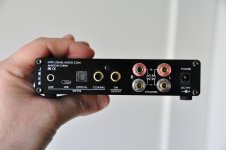 DSC_0971-scaled30.jpg577.6 KB · Views: 847
DSC_0971-scaled30.jpg577.6 KB · Views: 847 -
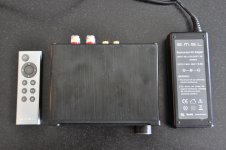 DSC_0969-scaled30.jpg791.1 KB · Views: 911
DSC_0969-scaled30.jpg791.1 KB · Views: 911 -
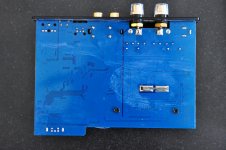 DSC_0972-scaled30.jpg860.4 KB · Views: 823
DSC_0972-scaled30.jpg860.4 KB · Views: 823 -
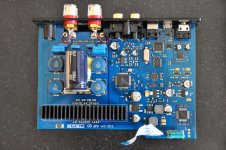 DSC_0974-scaled30.jpg167.8 KB · Views: 869
DSC_0974-scaled30.jpg167.8 KB · Views: 869 -
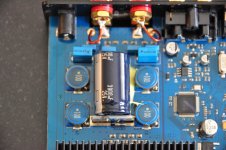 DSC_0975-scaled30.jpg888.6 KB · Views: 827
DSC_0975-scaled30.jpg888.6 KB · Views: 827 -
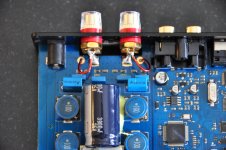 DSC_0976-scaled30.jpg878.8 KB · Views: 364
DSC_0976-scaled30.jpg878.8 KB · Views: 364 -
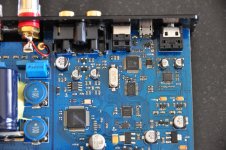 DSC_0977-scaled30.jpg969 KB · Views: 398
DSC_0977-scaled30.jpg969 KB · Views: 398 -
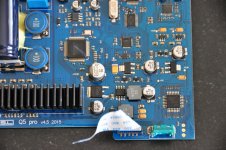 DSC_0978-scaled30.jpg970.6 KB · Views: 376
DSC_0978-scaled30.jpg970.6 KB · Views: 376 -
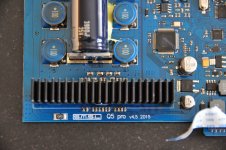 DSC_0979-scaled30.jpg937.6 KB · Views: 431
DSC_0979-scaled30.jpg937.6 KB · Views: 431
If you're interested in a FDA with more space for modding then have a look at the Popu 'Mercury'. On Taobao the basic model is almost half the price of the Q5. You don't get USB though with the basic one, just S/PDIF (coax and Toslink).
https://item.taobao.com/item.htm?spm=a230r.1.14.29.IqOf4S&id=19260362926&ns=1&abbucket=18#detail
https://item.taobao.com/item.htm?spm=a230r.1.14.29.IqOf4S&id=19260362926&ns=1&abbucket=18#detail
Hi,
really small indeed, not much space left. But you can still pull some music over
and enjoy 🙂
really small indeed, not much space left. But you can still pull some music over
and enjoy 🙂
If you're interested in a FDA with more space for modding then have a look at the Popu 'Mercury'. On Taobao the basic model is almost half the price of the Q5. You don't get USB though with the basic one, just S/PDIF (coax and Toslink).
https://item.taobao.com/item.htm?spm=a230r.1.14.29.IqOf4S&id=19260362926&ns=1&abbucket=18#detail
I have one. 🙂 I sprung for the "Pro" version. I posted some initial thoughts on it in this thread, "I AM D v200, Fx Audio d802, optimisation and TPA3116". My comments are in post #433. Eventually I post some pics of it. Short summary: the included 36V power supply is a turd, immediate improvement simply using a non-crap power supply. With a decent power supply, it's enjoyable. I can tell differences between it and the SMSL Q5 Pro, though I'm hard pressed to pick a winner.
The Q5 Pro has more bass; more than any other amp I've ever used, which makes me suspect it's over-emphasizing the bass somewhat. It does have EQ adjustments, and I was sure to set all those to zero. The highs don't seem "clean" enough to me. Despite all that, overall it feels "musical". The Mercury Pro, on the other hand, sounds overall "cleaner"... but sometimes has a hint of something "artificial" that I'm at a loss to describe, which takes away from the "musicality". It's not bad, just missing some of the "fun" factor.
Most of my description is probably meaningless to anyone but me. I strongly encourage everyone to take them with a massive grain of salt (like a whole salt mine). 🙂
Your description of how power supply matters immensely is far from meaningless to me 🙂 I've found the best sound with a single transistor (EF) regulator to feed mine, which in turn is fed from a TL431 voltage reference. Needs a fairly high gain transistor (I use one from Zetex/Diodes) to ensure enough peak current.
I think the supply is most important with class D as the efficiency of the amp means it's got a load that varies with the music. That included the resistance of those thin leads from cheap supplies too.
I could see the benefit of running a regular SMPS into a linear regulator dropping a couple of volts - Abraxalito is that what your EF regulator is? I imagine a voltage reference into a follower (perhaps a darlington) might be quite helpful in preserving the rail voltage much faster than the SMPS itself which is usually what we rely on.
I could see the benefit of running a regular SMPS into a linear regulator dropping a couple of volts - Abraxalito is that what your EF regulator is? I imagine a voltage reference into a follower (perhaps a darlington) might be quite helpful in preserving the rail voltage much faster than the SMPS itself which is usually what we rely on.
Yes, its an emitter follower with the base held at a Vref provided by a TL431. As such it has a fairly low drop out voltage and quite good HF rejection. This sounds better than including the EF inside the TL431's feedback loop.
This sounds better than including the EF inside the TL431's feedback loop.
It's a great idea, I'll add this to my testbed amp. The feedback within the follower will be far faster than any other feedback loop and should give a great benefit. I can also wind up my SMPS back to 36V to give a little voltage drop for the follower to work on.
What transistor did you use?
https://www.diodes.com/products/dis...-table/transistors-55v-to-100v/part/ZXT1053AK
I'd not recommend using this part with 8R or lower speakers connected as its maximum current wouldn't be sufficient. You'd probably need to use two, one for each channel which would involve some PCB mods to separate the rails. I modified my amp to run at higher impedances with an OPT.
I'd not recommend using this part with 8R or lower speakers connected as its maximum current wouldn't be sufficient. You'd probably need to use two, one for each channel which would involve some PCB mods to separate the rails. I modified my amp to run at higher impedances with an OPT.
The included laptop-style PSU is 19V; likewise, the DC input label on the device itself says 19V. Does anyone know if I can safely run this thing at other voltages? In particular, I'd like to feed it 13.8V from an Astron power supply. That's the only "mod" I can really do right now, as all my stuff is boxed up for a move to a new house. (Which was the justification for buying this thing in the first place: one small device that just works so I can pack up all the DIY clutter I have strewn about the house.)
Bit late, but I just got one too. It runs fine on 13.8v, however the power is lacking at this voltage. I run it at 24v and it sounds better that way. It does get a bit warmer. The USB input is not the best, I get better results with my LJM CM6331 USB to Coax. Great value amp. I am waiting for an Alientek d8 to compare.
- Home
- Amplifiers
- Class D
- SMSL Q5 Pro Mods